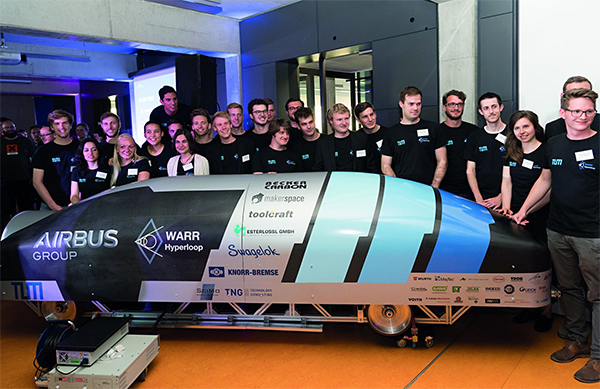Showcasing the transport systems of the future
A revolutionary transport system called Hyperloop has recently been showcased at the CADENAS Industry Forum. Despite sounding like something from a science fiction movie, the project claims that it is capable of travelling the distance of Los Angeles to San Francisco in 35 minutes - a distance of around 570km - which equates to a speed of 1,125km/h.
Currently, teams of students from all over the world are taking part in the Hyperloop Challenge, originating from Elon Musk, the founder of SpaceX. In the process, a transport capsule is to be conveyed through a tube with a vacuum. How much potential this approach has is shown by Lufthansa's interest in the Hyperloop technology for high speed trains.
As a part of the CADENAS Industry Forum convention in March 2017, two successful Hyperloop teams introduced their projects. The Ryerson's International Hyperloop Team (RIHT) from Toronto and the WARR Hyperloop Team from the TU Munich. Both belong to the 27 finalist teams which presented their prototypes in Los Angeles in January.
“We are all young and ambitious and, as nearly all engineers, fans of Elon Musk and his projects. We wish to participate in the innovations and see the Hyperloop project as an excellent opportunity to be a part of the technological change in the world,” commented Graeme Klim, Project Leader of RIHT.
With the WARR Hyperloop Team Scientific Workgroup for Rocket Technology and Aerospace) of TU Munich, a total of 40 students developed a prototype of a Hyperloop capsule. The so-called Pod was given permission to start on the SpaceX test track in Los Angeles in January, along with only two other prototypes. At this first contest, the Pod from Munich was the fastest and took first place as the only one to reach the finish line. The second contest will take place in August and in June the student team from the TU Munich will be introducing their second Hyperloop prototype.
Gabriele Semino, one of the project leaders of the WARR Hyperloop Team, reported about his motivation for the student project: “We’re developing something that’s never been tried before. Some of the technologies we use already exist in other application areas. But we’re combining them completely new and under other framework conditions, such as in the partial vacuum.” That’s why every component had to be carefully tested and adjusted.
“Our detailed tests proved to be great advantages for the contest and test racing. And so we learned what is feasible and what is not,” said Catriona Bruce, Propulsion & Levitation on the WARR Hyperloop Team. In particular, the turbine in the front section underwent intensive testing which, up to now, had only been used in aeroplanes under normal pressure conditions. In the WARR Hyperloop capsule, it ensures that the air is guided to the rear and not pushed ahead by the capsule in the partial vacuum. This serves to minimise resistance and friction. The turbine demonstrated the special feature of the prototype from TU Munich and proved itself successful during the test run in California.

Ryerson’s International Hyperloop Team (RIHT) of Ryerson University, in Toronto, with its six members, focuses on a certain subsystem of the capsule with the Hyperloop project. The so-called Hyperloop Deployable Wheel System (HDWS). “Like the construction of an aeroplane, where various companies from different countries work on single parts, we are specialised in the certain area of the Hyperloop capsule. We took an entire year to optimise and perfect the wheel system in detail,” said Tayo Shonibare, Controls & Electronics of RIHT.
The Hyperloop wheel system from Ryerson’s International Hyperloop Team consists of around 204 components, 162 standard parts of which were used. In order to speed up the design process, the Canadian Hyperloop Team uses National Aerospace Standards (NAS), supplied to the Aerospace Industries Association (AIA) and IHS Markit in cooperation with CADENAS.
During the CADENAS Industry Forum, the RIHT Team showed how easy it is to find and download the 3D CAD models in the NAS product catalogue, and then to integrate into the existing design in the CAD system CATIA. “The Strategic Parts Management PARTsolutions from CADENAS would of course make finding components that much easier. As soon as we change our previous CATIA student version to the regular version, we will use PARTsolutions. It will make our design process easier and faster,” Graeme Klim added.
Just as in the industry and economy, also in the Hyperloop Project the costs play a major role. Although no cost limits have been specified by the Hyperloop contest, each team presented a plan at the beginning about how much money has been made available to them by e.g. sponsors. “We are especially interested in sponsors who contribute components for our prototype and that we can fall back on their know-how. That was possible, for instance, for the turbine used, which is very expensive,” confirmed Gabriele Semino.
Support with the finding of suitable components was instantly possible for the team from Munich with the help of CADENAS. The German software company made the licenses for the Strategic Parts Management PARTsolutions available for them. Sponsors also play a central role for the Canadian Hyperloop Team. “Even with our cost plans we set up, surprise costs came up time and again in the course of the project. Fortunately, our sponsors are very generous and support us. All of the companies who support us, including CADENAS, are very excited about the Hyperloop Project in general and the work of our team.


